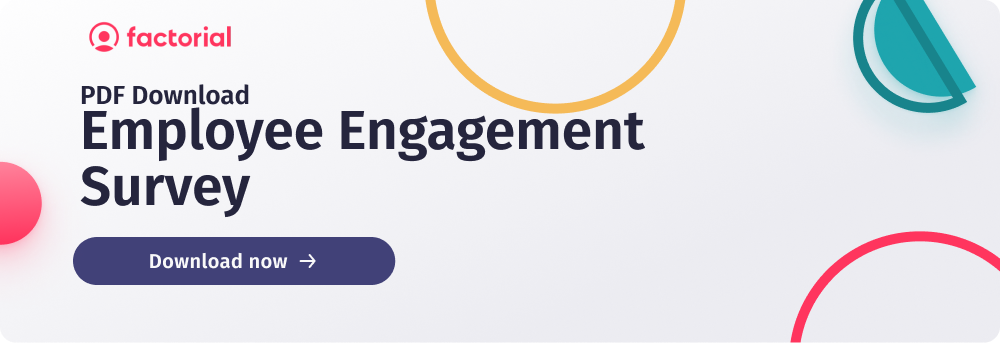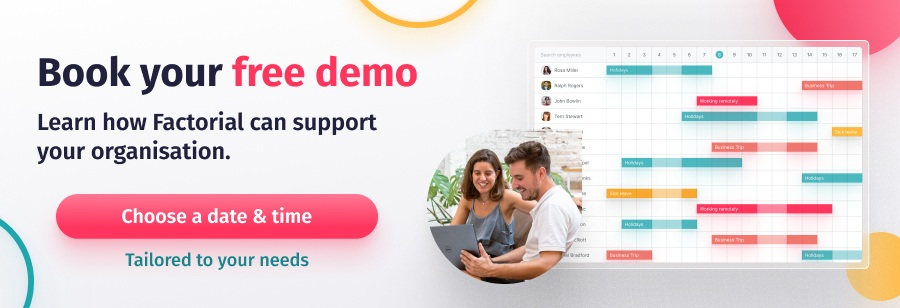According to Gallup, organisations with high engagement levels report 22% higher productivity. Of course, this is massively important for business success, but engagement is about much more than that.
Engaged employees are also more focused, driven, more likely to power innovation and less likely to leave their company. For this reason, measuring employee engagement and optimising the work environment to foster it should be a top priority for companies.
The best way to keep your finger on the pulse is through employee engagement surveys. Implementing these allows you to collect employee data straight from the source, allowing you to identify trends and actionable insights.
Table of Contents
What is Employee Engagement?
Employee engagement is the way someone thinks about their company, their attitudes towards it and the emotional commitment they feel with it. Highly engaged employees feel a stronger connection to their place of work and and are more invested in helping their organisation reach its goals.
An employee engagement survey gathers feedback from team members to measure satisfaction with the workplace, identify drivers of engagement and areas that could be improved. Essentially, an employee survey attributes a score to the connection employees feel to their organisation so that HR teams and company leaders can optimise the workplace.
Purpose of Employee Engagement Surveys
During the pandemic, employee engagement in the UK dropped by -11%. This comes as no surprise, but what does is that it’s only recovered by +3% since, leaving us trailing behind France, Australia and the US.
Employee surveys are the most effective way to boost this figure back to pre-pandemic levels – or ideally higher. They offer a chance to gather employee feedback and collect key metrics that can be translated into organisational change. Asking survey questions can help to:
- Increase employee engagement levels and employee satisfaction: Employee engagement survey results are the best way to identify blockers to engagement and put measures in place to overcome these.
- Identify motivated employees: These are the people with potential to become senior leaders and drive employee engagement in other team members.
- Make employees feel heard: Employee participation in engagement is important for engagement itself. When people feel their opinion is valued and that their feedback affects change, they will feel a stronger emotional connection to their place of work.
- Improve business outcomes: An engaged employee will work harder to meet company objectives.
- Unite global workforce: Pain-points can look wildly different across international teams. An employee survey can highlight inequalities across the board and support your in equalising these.
- Reduce absenteeism and turnover: The State Of The Global Workplace report revealed that organisations with actively engaged workers see an 18% decrease in staff turnover – and the high costs associated with this.

Pulse Surveys vs. Employee Engagement Surveys
There are two main types of employee survey: pulse surveys and employee engagement surveys. The survey process is slightly different for both. The former is a shorter set of questions sent to employees on a regular basis, each time based on one specific topic (e.g. flexible working, work socials, learning opportunities). The latter is a longer survey shared with people less regularly but covering more subjects.
Conducting Employee Engagement Surveys
There’s an overwhelming amount to consider when conducting employee engagement surveys. Let’s break it down, step-by-step.
1. Design the Survey
Before you start writing survey questions, you need to consider the survey layout and format. An employee engagement survey should be intuitive and easy to answer if you want to maximise engagement rate. Getting employees to answer can sometimes be the hardest part!
The main factor to consider is ease. Your employees are busy with their day-to-day, so answering survey questions shouldn’t be perceived as a lengthy or difficult additional task.
You’ll also need to consider:
- Survey length: The ideal length of an employee engagement survey is 30-40 questions. For a pulse survey, this decreases to 10-15. Keeping it relatively short drives employee engagement.
- Format of questions: Are you going to ask open ended survey questions or closed questions? Which questions will be optional and which will be compulsory? We would recommend using the 5-point Likert scale which prompts employees to rank their beliefs from 1-5 (such as strongly agree to strongly disagree). These are easier and quicker for employees to answer and therefore increase participation, and the results they produce are more comparable and actionable.
- Respondents: Who are you asking? Decide your target audience and, if it’s a specific group only, explain why you’re asking them and not everyone.
- Timeline: Set a survey launch date and final deadline, and communicate both clearly to respondents.
- Owner: Who is responsible for galvanising your workforce to answer? This person is also in charge of sending reminders and signing off on the project once survey results are in.

2. Write Your Questions
The success of your employee engagement survey hangs on the questions you ask your employees. They need to prompt answers that will shed useful insights and create a good understanding of the changes that need to be made.
Your employee engagement survey questions should be based on:
- Employee engagement. The focus here is employees’ involvement in the company and how favourably they look upon the company. These are directly about satisfaction.
- Primary themes. These questions should ask about the factors that impact engagement, including:
- Autonomy
- Career development opportunities
- Teamwork, collaboration and communication
- Diversity, equity and inclusion
- Compensation
- Product quality
- Leadership, management and hierarchy
- Rewards and recognition
- Company culture
- Work-life balance
- Tools, software and resources
- Learning and development
- Health and safety
- Hybrid work environment
- ESG.
- Extra themes. An effective employee engagement survey will ask additional questions based on the context of the company at the time and anything out of the ordinary happening.
3. Deploy the Survey
Put simply, more responses means more accurate data and more impactful change. Generate as much buzz around your employee engagement survey as possible. Post about it on internal communication channels or smaller focus groups if you’re targeting a specific subset of employees.
Get leadership buy in and ensure they raise visibility of the survey and drill in its importance. All of this will increase the amount of responses you’ll receive and your chances of fostering a highly engaged workforce and improving employee experience.
4. Measure Employee Engagement
Four crucial ‘enablers’ of employee engagement were identified by The Macleod Review. Together, these form a solid categorisation framework to group your findings. They are:
1. Leadership. A ‘strategic narrative’ about the company should stem from this.
2. Line managers. They should empower employees to boost employee performance and improve the overall employee experience.
3. Employee voice. Again, this is about being heard and having a say in company decisions.
4. Integrity. Company culture should encompass the values of the organisation. You should be talking the talk and walking the walk.
Use your findings of your engagement survey to allocate a number score to each of these areas and build a cohesive picture of engagement. Work out what the data is telling you about employee experience by turning the metrics into digestible graphs to show to senior stakeholders. Dig deeper into the answers of your ‘disengaged employees’; is there a common theme between them that could indicate areas of improvement?

Employee Engagement Survey Questions
Here are some example employee engagement survey questions that could be asked with the 5-point Likert Scale as an answering format (unless starred).
- “I would recommend [Company name] to my friends as an enjoyable place to work”
- “I never think about searching for a job elsewhere”
- “I am kept in the loop about company updates by business leaders”
- “My manager cares about my wellbeing”
- “My manager cares about my career aspirations”
- “I have the tools, resources and software to do my job effectively and to the best of my abilities”
- “I have access to the training programmes that my role requires”
- “I can see myself at this company in [x] years time”
- “Career paths are clear at [Company name]”
- “My hard work is recognised and fairly rewarded”
- “How satisfied or dissatisfied are you with your current workload?”*
- “Is there anything you would like to mention that hasn’t been covered in this survey?”*
Employee Engagement Survey Software
When it comes to generating and deploying engagement surveys to increase employee engagement, Factorial makes it easy.
You can manage surveys from the same place as other key HR processes from an all-in-one, cloud-based platform. Select from our pre-designed survey templates or create custom surveys from scratch. The formatting is totally up to you; select mandatory or optional for each question and choose your answer type (either rating, open, and more). You can even make surveys totally anonymous to increase the honesty of responses, then view them all in one, centralised place as well as who is yet to complete it.
Our Internal Communication tool then makes it easy to share the survey and generate engagement from employees.
Being an employee engagement survey vendor is only part of who we are. You can learn more about Factorial’s other features here, including time management, talent management, documentation, expenses and more.








